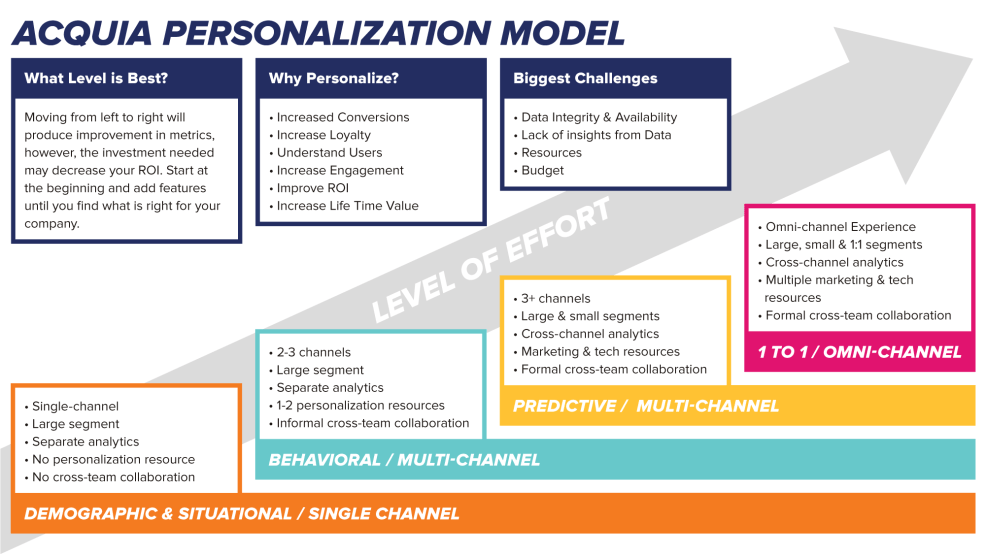
Acquia’s Personalization Maturity Model for Driving Engagement

Personalization isn’t a new concept, yet many marketing teams still struggle with where to start and how best to leverage it within their company.
One-to-one customer experiences are often associated with personalization, but in reality there are varying degrees of personalization. If you try to jump right to one-to-one customer experiences, you’ll quickly become overwhelmed. It’s best to start small, gather insights, and continuously optimize over time. It’s similar to preparing for a marathon. If you’ve never run one before, you would likely start out with a shorter race before preparing for the full 26.2 miles. In other words, you'd follow the “Crawl, Walk, and Run” approach.
Personalization is not any different. As with any achievable goal, there are small steps you can take that will build up to your objective.
The “Crawl, Walk, Run” approach to web personalization
“Crawl” personalizations are ones you can start with immediately from a content and data standpoint. These are generally low effort (meaning general, easily collected data and personalizations that can be ongoing), of varying impact, and with fast results.
Some examples of crawl personalizations are:
- Geolocation: For those visiting the site from a specific city, personalize a section of the homepage with information or registration for a local event that you are sponsoring or attending in that city.
- Marketing campaigns: For those who received an email with a specific UTM code, if they click on the link from the email, create a consistent experience across channels by personalizing the homepage to match the content in the email.
- Visit frequency: First-time visitors will see “About us” content prominently displayed on the homepage above the fold, while visitors who have been to the site before will not see this information above the fold. Instead, you could offer returning visitors an opportunity to sign up for a newsletter or to receive a piece of popular content.
- Device type: For mobile users, you could evaluate your analytics to see which content is most popular with mobile users and provide them with that content on the homepage.
“Walk” personalizations will usually require additional content and more data collection for further defined segments. These are medium to high effort (data that may require multiple visits and additional content creation), with medium to high impact.
Some examples of walk personalizations are:
- Browsing behavior: Tag blog, video, and other web content that aligns to a specific segment you want to track. When visitors interact with that content more than others, deliver even more relevant content to them on other sections of your website, including the homepage and interior pages as they browse.
- Pages viewed: Here, you can contextualize the site based on multiple views. If a visitor has looked at awareness-type content multiple times in a 30-day period, you could serve them conversion content on their next visit. Or if someone has visited a page about a specific topic several times, you could serve them new content that’s been created on that topic when they visit the homepage.
- Completed events: For visitors who have taken an action (e.g., signing up for a webinar, attending an event, or subscribing to a newsletter), you can serve them reminders about that event or content, invite them to a similar or related event, or show them an action/ask related to the next stage of the marketing funnel.
“Run” personalizations will require additional content, more personalization events, and more data for further defined segments. They are high effort (requiring data collection and integration from other systems, moderate to extensive content creation, and more research and manpower to build and execute rules) with high impact during an extended period of time.
Some examples of run personalizations are:
- Integration with other systems: Leverage data from tools like your customer data platform (CDP) or customer relationship management (CRM) system, and personalize content on sites or mobile apps based on their segment IDs or other identifiers in those systems.
- Cross-channel: Following an order on a mobile website, you can offer a discount or free delivery coupon via e-mail or the next time the user logs onto the mobile app.
- Combination of multiple crawl personalizations: Show regional content to visitors from that region who arrived at the site by clicking on a PPC online ad.
As you see, there are a number of approaches to creating personal experiences for your audience, and one-to-one personalization does not necessarily have to be your primary framework. Every company’s level of personalization needs will be unique, and not all organizations have the internal structures and processes in place that are conducive to one-to-one personalization.
Setting personalization goals with a personalization maturity model
Making a customer feel like the content you provide is relevant to their unique situation is what personalization is all about. Yet, many customers share a common set of characteristics that can help to define your personalization strategy. So, as you start out with personalization, focus on segmenting customers into groups based on similar needs and creating experiences around those needs. You’ll gain valuable insights and can optimize your marketing and content strategy based on those broad customer segments.
Acquia’s Personalization Maturity Model can help you define realistic personalization goals. This Maturity Model is designed to help you realistically assess your personalization goals based on several factors that will be unique to your company, such as:
- Goals: What are you trying to achieve with personalization and do you have multiple goals or a single goal such as conversion?
- Channels: Is your organization seeking to reach an audience across multiple channels or to focus on one primary channel such as a website?
- Resources: Do you have a team dedicated to personalization full-time or will this be managed part-time by a single resource?
- Organizational Collaboration: Has senior leadership approved personalization as a key initiative with a cross-collaborative team or is one department owning this initiative?

We encourage teams to take an in-depth assessment of their organizations, including the internal structure, the resources available, and the level of commitment, to set realistic goals for personalization. Teams do not need to strive for an omnichannel, predictive, one-to-one personalization strategy if this is not the level of personalization your organization currently requires. Instead, it is important to find the level that’s right for your company and set achievable objectives that can be built upon over time.
We’re here to partner with organizations in their personalization efforts. Take the first step toward achieving your personalization goals by checking out our e-book, “Fast Track Your Organization's Ability to Deliver Personalized Experiences.”
This blog was originally published in 2019 and has been updated to remain current.

